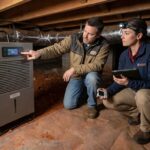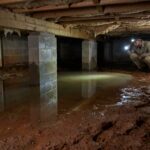Essential Guide to Choosing the Right Basement Waterproofing Solution for Your Home
When it comes to homeownership, few things are as yet frustrating (or potentially damaging) as a damp or leaky basement. Enter the world of basement waterproofing solutions—the unsung heroes of home maintenance that can save you from turning your cozy dwelling into a soggy mess. If you’re contemplating how to protect your castle’s lower level, buckle up as we dive into this essential guide to choosing the right basement waterproofing solution for your home.
Understanding the Need for Basement Waterproofing
Before we embark on this journey through the depths (pun intended) of waterproofing options, let’s take a moment to understand why you should care about basement waterproofing in the first place. A basement is often one of the most overlooked areas of a home, but it can also be a breeding ground for mold, mildew, and other unpleasant surprises if not appropriately maintained.
Water intrusion can lead to structural damage, decreased property value, and even health issues caused by mold spores in the air. So, if you’ve ever found yourself questioning whether you need to waterproof your basement, the answer is a definitive yes! But fear not; with the right information, you can choose a solution that suits your specific needs.
Identifying the Source of Water Problems
Before you rush to the nearest home improvement store for a bucket of sealant, it’s essential first to identify the source of your water problem. The most common culprits include:
1. **Groundwater**: During heavy rainfall or snowmelt, groundwater levels can rise, leading to seepage through walls or floors.
2. **Surface Water**: Poor drainage around your home can cause water to pool near the foundation, finding its way inside your basement.
3. **Plumbing Issues**: Sometimes, the enemy lies within—leaky pipes or overflowing appliances can create unwanted moisture.
4. **Humidity**: In some cases, excessive indoor humidity can lead to condensation, making your basement feel like a humid jungle.
By determining what type of water problem you’re dealing with, you’ll be better equipped to make an informed decision about waterproofing options.
Assessing Waterproofing Solutions
Once you’ve identified the source of your water woes, it’s time to explore the various waterproofing solutions available. Each option has its pros and cons, so let’s break them down:
1. **Interior Waterproofing**
Interior waterproofing involves sealing your basement from the inside to prevent water from entering. Common methods include:
– **Sealants**: These are applied to walls and floors to prevent water penetration. They work well for minor dampness but may not hold up against significant water pressure.
– **Sump Pumps**: A sump pump is a mechanical device installed in the lowest part of your basement to pump out any accumulated water. When the rains come (or you accidentally overflow your bathtub), it’s your basement’s best friend.
– **Interior French Drains**: These systems involve installing a trench with a perforated pipe that collects groundwater and directs it to the sump pump. This method is effective for managing water that seeps in, but it won’t stop water from coming through the walls.
2. **Exterior Waterproofing**
For those dealing with a more severe water intrusion issue, exterior waterproofing is your knight in shining armor. This approach involves addressing the problem from outside your home, which can be more effective in preventing water from ever entering your basement.
– **Excavation**: This labor-intensive method involves digging around your foundation to waterproof the exterior walls. Once exposed, contractors will apply waterproof coatings and install drainage systems to direct water away from the foundation.
– **Waterproof Membranes**: These specialized materials are applied to the outside of your foundation walls to create a barrier against water infiltration. Think of it as a raincoat for your house!
– **Installing Exterior Drains**: By creating a drainage system that moves water away from your home efficiently, you can prevent many water problems before they start.
3. **Water Diversion Techniques**
Sometimes, the best defense is a good offense. By improving the drainage around your home, you can significantly reduce the amount of water that makes its way to your basement.
– **Gutters and Downspouts**: Ensure your gutters are clean and functioning correctly, directing water far away from your foundation. An ounce of prevention is worth more than a pound of cure when it comes to rain!
– **Grading**: The slope of your yard should direct water away from your foundation. If your property is graded toward the house, consider regrading it or adding landscaping features to divert water.
– **Dry Wells**: Installing dry wells can help absorb excess water from your yard and allow it to drain away from your foundation.
Cost Considerations
As with most home improvement projects, cost can be a significant factor in deciding on a waterproofing solution. Interior solutions tend to be less expensive upfront but may require ongoing maintenance or become less effective over time. Exterior solutions are typically more costly due to excavation and labor, but they can offer peace of mind and long-lasting results.
It’s essential to budget accordingly and get multiple quotes from different contractors or service providers. Remember, the cheapest option isn’t always the best; consider the long-term effectiveness of the solution you choose.
DIY vs. Professional Help
You might be tempted to tackle a basement waterproofing project yourself, especially with the plethora of online tutorials available. While some minor fixes, such as applying sealants or cleaning gutters, can be handled by handy homeowners, more complex issues usually require professional expertise.
If your water problems are severe, such as extensive flooding or continuous seepage, hiring a professional waterproofing contractor is likely the best route. They can assess the situation and recommend tailored solutions that will effectively address your specific challenges.
Choosing the Right Waterproofing Contractor
If you’ve decided to enlist the help of a professional, selecting the right contractor is crucial. Here are some tips to make sure you find an expert who suits your needs:
1. **Check Credentials**: Verify that the contractor is licensed, insured, and experienced in basement waterproofing.
2. **Read Reviews**: Look for testimonials and reviews online to gauge customer satisfaction.
3. **Get Multiple Quotes**: Don’t settle on the first quote you receive. Comparing pricing and services can help you find the best deal.
4. **Ask About Warranties**: Reputable contractors will often provide warranties for their work. Don’t hesitate to ask!
5. **Communicate Your Needs**: A good contractor will listen to your concerns and tailor their approach accordingly. Don’t be shy—speak up!
Common Myths About Basement Waterproofing
As we wrap up our waterproofing odyssey, let’s debunk a few common myths surrounding this important home improvement topic:
– **Myth 1**: Waterproofing is a one-time fix. False! Regular maintenance and inspections are necessary to keep your basement dry.
– **Myth 2**: All waterproofing solutions are messy. While some methods (like excavation) can be disruptive, many interior solutions can be done with minimal mess.
– **Myth 3**: You only need to waterproof if you see water. Unfortunately, it’s often the unseen damage (like mold) that can create the biggest problems.
Final Thoughts
Choosing the right basement waterproofing solution is essential for protecting your home from water damage. By identifying the source of your issues and exploring the various options available, you can make an informed decision that suits your needs. Whether you opt for interior waterproofing, exterior solutions, or preventive measures, remember that a dry basement is a happy basement!
So roll up your sleeves, do your research, and ensure your home remains the fortress it was meant to be—dry, safe, and sound. After all, you can’t spell “basement” without “safe,” right? (Okay, maybe you can, but you get the point!)


